Lights Up
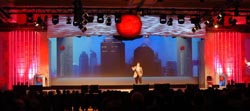
- If it's that (short) stretch between PLASA in London and LDI (this year in Las Vegas), it's time to step away from my day-to-day business commitments and take a broader look at whats happening in our industry. I keep up pretty well year-round, but there is always something new that turned up at PLASA that warrants examination in the upcoming LDI show in Las Vegas. And this year's there's been more evolution in the lighting world than usual, with developments on many fronts.
Lighting as Staging: Versatubes (Stage left and right) at and LMG-staged event.
LED LED LED. Theyre everywhere, and for a reason. LEDs are the biggest thing to happen in lighting since the Edison light bulb, and these fixtures are getting more useful (read: bright) every day. Looks like the Color Kinetics (www.colorkinetics.com) vs. SuperVision (www.supervision.com) patent battle has been decided (for the moment) in Color Kinetics favor generally, and CK has now negotiated licensing agreements will almost all of the major manufacturers of LED fixtures. This has opened the door to a load of fixtures from all over the world. There are many offerings targeting architectural of course, as that has been the first broad market for LED fixtures due to the early offerings limited output. But there are now several road-worthy fixtures to choose from. Seems like the Thomas Pixelline (www.jamesthomas.co.uk) fixtures have established themselves as the road rental of favor in America, but Color Kinetics, Pulsar (www.pulsar.com.uk), AC Lighting (www.aclighting.com), TMB (www.tmb.com) and others are also getting shows and sales. Martin (www.martinpro.com) also entered the LED fray at PLASA 2006 with an interesting range of LED fixtures utilizing combinations of multicolor LEDs with white LEDs for improved spectral balance.Thats one of the big issues with LED fixtures, the spectral balance of color. Along with quality dimming, control options and no hard-edge fixtures with anything bordering on useable output. Ive seen several threads on the LightNetwork discussion forum (www.lightnetwork.com) about these topics, and theres even a separate section for LED fixtures. Lets briefly discuss the spectral balance issue. LEDs are very narrow emitters of light when compared to sources like tungsten, fluorescent or even metal halide. RGB LEDs do a great job of creating a lot of very useable colors, but theres a lot of visible real estate left in between those red, green and blue LEDs. Thomas added amber to their fixtures to improve the color range, and Selador (www.selador.com) has shown a seven-color LED fixture that claims to help solve this problem. In the short term, I see LED fixtures being used to light set pieces, architectural elements, trade show booth panels, truss, etc.
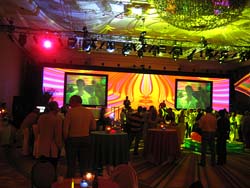
High End Systems' new Collage Generator feature for their DL.2 spelled the solution for Montblanc's recent meeting in Miami. Collage Generator is a software feature, which allows the user to link multiple DL.2s to create seamless panoramas. LD Jeremy Breger specified ten High End Systems DL.2 Digital Lights to create a 65-foot by 20-foot seamless panorama as a backdrop for the luxury pen company's corporate gathering at the Loews South Beach hotel.
Basically everything but people. I havent seen an LED fixture that rendered color on human beings that could compete with the spectral balance of a Source Four yet. But that will change, and thats the trend Im watching for closely. And a hard-edge LED fixture with useable output. Thank you automotive headlamp developers. Theyre spending a lot of dough figuring it out for us! Maybe Dialight (www.dialight.com) will have something new this year, they showed a promising S4 prototype a couple years ago.And lets not forget the other entertainment LED products that aint exactly illumination and ain't video displays. The Element Labs Versa Tubes (www.elementlabs.com) and the Main Light SoftLED/Scrim (www.mainlight.com) come to mind. These are what I would call low-res LED displays, mostly applied as scenic elements to wonderful effect. And wow are they popular. The Versa Tubes are polycarbonate tubes with a line of LEDs down the center, hung in arrays and fed video signals. The SoftLED/Scrim is a see-through mesh scrim with LED nodes attached that folds and hangs just like a scrim, and the mesh appears transparent until you power up the LEDs, which are also fed a video signal. Speaking of that, there will an excellent seminar this year on pixel-mapping, which is the process of assigning the pixel output of media servers to RGB DMX addresses on these fixtures. This allows for much better effects with much easier DMX programming. Heres a link for info:http://ldishow.com/conference/led_pixel_mapping
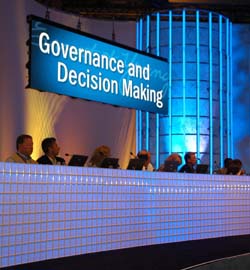
For an Ernst & Young meeting at Gaylord Palms Convention Center in Orlando, LMG used LED-based effects, Versatiles (foreground), together with Versatubes to support the visual message of the meeting.
Digital Lighting
This is the other technology that stands to change everything, and it looks like High End Systems (www.highend.com) is enjoying the market leadership position with their Catalyst, DL1, and DL2 digital lighting products. They also offer ArenaView, a digital lighting/signage/advertising product package for arenas and other large spaces. While the original target audience of lighting designers and users have embraced the technology since the first showing of Light and Sound Designs Medusa projector system in 1998, rental and staging companies have been jumping on the digital lighting bandwagon even faster. All it takes is seeing the images and energy that can be created with just two or four units. Theres a lot of buzz about the new Collage Generator feature in DL2, which allows the user to feed a single image to multiple projectors, and the software breaks the image up between the projectors to make a big image, automatically. As High End is enjoying quite a lead in this arena and are obviously selling gear, it makes you wonder why they are still virtually alone with all of these hungry lighting (and video) manufacturers around?
I mentioned the LSD Medusa (www.prg.com) earlier as being the first digital light anyone remembers. Its also the source of a great body of digital lighting intellectual property (IP), mainly in the form of patents currently held by PRG/VLPS. High End Systems also holds a large digital lighting IP portfolio, and there are others like Vari-Lite and WWG that also hold pertinent IP. Why is all this IP stuff important? Because if youre looking to manufacture a digital lighting product, I dont see how it could be done without infringing some of PRG or High Ends digital lighting patents. This means manufacturers will have to license these technologies to produce product without the threat of lawsuit, much as has happened with Color Kinetics in the LED marketplace. Which is only fair, I might add. Its also interesting to add that PRG/VLPS has not made a significant investment in digital lighting yet, fueling rumors they are working on something themselves or in tandem with a lighting manufacturer. They certainly have the IP to accomplish the task, along with Jim Bornhorst, legendary developer of the VL1. Maybe they will show something this year?
As for other digital lighting products appearing at LDI, Robe (www.robe.cz) showed their digital light at PLASA, but I havent heard if it will be shown at LDI. There is a confirmed rumor that a major manufacturer of large-venue DLP projectors has been working on a digital light engine, a specialized projector that uses both standard video imaging technology coupled with automated lighting technology like effects wheels, faster better optimized zoom and focus, dark shutter, etc. But I heard they will be showing it at LDI as a static projector (not on a yoke as a DMX-controlled digital light) due to IP issues in the process of being addressed, but thats only a rumor at this date.
It appears High End Systems has a lock on digital lighting (in America at least) for the foreseeable future due to two factors advanced development that is ahead of any other manufacturer to-date and access to the IP necessary to produce the product.
Media Servers
Just because High End has the lock on digital lighting doesnt mean that they arent other imaging devices available, but they sure whetted the appetite of the market with Catalyst, the first DMX-controller digital media server that most lighting people have heard of. But they arent alone: PRG/VLPS, Martin, Green Hippo, MA Lighting, Diagonal Research, aKaos and others all offer digitally controlled media servers with cool features too. Its interesting and cool that video people are finally warming up to what these devices have to offer productions of all kinds, especially the bang for the buck one realizes from digitally controlled media servers.
A daily selection of the top stories for AV integrators, resellers and consultants. Sign up below.
Also, not all of the servers have to be directly digitally controlled by DMX. The Martin Maxedia offers a programming screen where complex cues are created and previewed. Then the DMX from the consoles simply calls that cue up, controls rate and dimming, etc. as opposed to controlling every single attribute of the server via DMX or you can play them back from the interface if you wish. If youve ever used one of these media servers and enjoyed the 200+ per server DMX channel counts, you might appreciate this approach.
Control consoles I have never seen such a broad choice of top-end lighting control systems. Since only one or two control systems get sold for every system out there, control manufacturers dont see the unit volumes fixture or dimmer manufacturers enjoy. ETC/Avab, Genlyte/Strand, Colortran, Avolites, GrandMA, Martin, Flying Pig Systems, Jands, Compulite and Chamsys all offer consoles with four or more DMX outputs, automated and conventional lighting control, previsualization options, networking, multiple monitors, touchscreens, you name it. Frankly I dont see how all of these manufacturers manage to stay in business with the cost of software/hardware development vs. number of units sold, but then again maybe the lighting industry has grown more than I give it credit for. In any case, if you cant find a controller that is set up to cue like you imagine it should, something is seriously wrong (with you).
So how do you choose which one to buy? Im asked this question asked all of the time. The real questions to address are what do your people & clients know how to use, what do you clients ask for and what can I get consistent service and software updates for?
Previsualization
CAST Lighting of Toronto (www.castsoft.com) introduced the world to lighting pre-vis several years ago with the introduction of WYSIWYG, which allows the user to see a version of his design in real-time and program within it with a DMX lighting console. Since then ETC has packaged WYSIWYG with their Emphasis control systems and brought pre-vis to education and other markets. Other popular pre-vis products include Martins Show Designer and ESPs Vision 2 package. All of these systems have come down in price in the last few years, so Im surprised the rental and staging industry (everyone, really) doesnt use pre-vis more.
In fact, CAST Software has released Vivien, which is a version of WYSIWYG specially developed for meeting planners and staging companies to design their shows and provide pre-visualization of the event. Vivien also keep up with your paperwork, providing pull lists for items like tables and chairs based upon the design. And its pretty reasonably priced from what Ive heard.
25 years of automated lighting
Do you realize the profound impact TEXANS have had on the world of entertainment lighting?!! The visionary, hard-working people at Vari-Lite (www.vari-lite.com) of DALLAS, TEXAS introduced the modern automated light and control console 25 years ago this year and I say saaaa-lute. The Vari-Lite stand at LDI 2006 will feature a display of all of the Vari-Lite fixtures going back to the VL0, which Ive heard was one of the coolest things to see at PLASA this year. Ive also heard Genlyte is selling the hell out of the VL500 wash light (its the 2006 model VL5 for the rest of us)... congratulations!
Chinese and Eastern Europe products: like much of the rest of industry, these areas are creating pricing pressures on the manufacturing of products, and automated lighting is no different. While there are some pretty big Chinese and Czech players like Elation, Robe and PR Lighting in the game, none of them has displaced any of the established big players like HES, Martin or Vari-Lite... yet. After 20 years in this industry Ive gotten to see some of the changes that take place, but I cant accurately predict who will be the next big player and if it will be a Chinese or Czech company. I do predict that offshore product will get better and better and thus provide more price pressure for established manufacturers.
The final word
LEDs and digital lighting are the bleeding edges of technology currently, but there is still plenty of conventional automated and theatrical lighting being used and sold every day. Its a very interesting time to be in the lighting business, to get to witness not one but two disruptive technologies like LED and digital rip through the fabric of the lighting industry... and the influence of low-cost offshore manufacturing. All of the latest grappling for customers dollars and attention will take place in a couple of weeks at LDI 2006 in Las Vegas, and thats always fun to watch. That and the pool at the Hard Rock Hotel. Come by and buy me a drink.
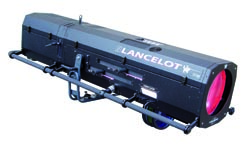
LANCELOT made its International debut at Plasa in London and will be the center of attraction in Robert Juliats booth 1033 at LDI 2006. The brightest fixture ever released by Robert Juliat, LANCELOT is both a long throw effects projector and a followspot, perfect for large venues. Designed around a 360,000 lumen 4KW HTI lamp, LANCELOT retains the Robert Juliat trademarks of flat field, smooth dimming control, fully closing iris, color changer and DMX control, but introduces a complete new and revolutionary modular design that employs plug and play cartridges to give the lighting artist many additional options. Cartridges are available now for progressive color effects, frost, color correction and color mixing. Future features will include up to two five position rotating gobo modules, motorized zoom, variable strobe and a moving mirror head. LANCELOT is currently in production. Interested parties are instructed to contact a Robert Juliat supplier for details.
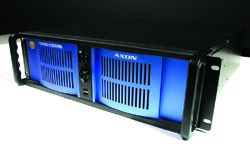
High End Systems is launching Axon, a rack-mount media server featuring the same graphics engine as the DL.2 digital light. Axon will be shown at High End Systems booth at the ETS-LDI trade show Oct. 20-22 in Las Vegas.
Axon is a flexible solution for those who already have their own video display device, and want a world of unlimited image possibilities.
"Axon has been a highly requested product since we first released the DL.2 last year," says Scott Blair, director of digital lighting development. "The ability for lighting designers and programmers to use a media server - which operates like the DL.2 - for other elements of their show represents an enormous time savings when programming a show by not having to switch between the programming syntax differences of other media servers. Axon puts all the features of the DL.2 Graphics Engine into a 3U rack mount that can be managed as simply as the DL.2 fixtures."
Axon provides all the functions of the DL.2, including the new Collage Generator and Curved Surface Support, but it allows the user to choose their own output device. Axon can feed video to High End Systems' DL.1, LED panels or large format projectors. Because it is controlled exactly as a DL.2, it fits in perfectly on shows with DL.2s needing an extra media server for other video display devices.
Axon is also helpful at the Front of House area for previewing content and programming for a show. Its useful for pre-programming DL.2 fixtures because they use the same DMX Library protocol. Axon can connect to another live video display source (such as a camera or DVD player) using an S-Video input.
Martin Enters LED Fray
With the new Stagebar 54 and LED curtain, Martin is bringing its lighting knowledge and dynamic color changing expertise to the world of LED. On display at the Martin booth (#194) at LDI.
Stagebar 54
The Stagebar 54 is a bright, high efficiency LED pixel bar with RGB, Amber and true white color mixing (RGBAW) for a broader color spectrum and greater range of pastel shades than other LED lights in its class. The Stagebar 54 features an automatic color calibration technique which assures that colors are always balanced to each other and show correctly. Light output is constant, regardless of ambient temperatures, and different lens angles give greater flexibility and a wider variety of application. Stagebar 54 also features high speed video capability. Mounting, connectivity and serviceability are all made easy and regulated fan speed ensures outstanding heat management, ensuring the fixtures long term performance. Industry standard DMX 512 controllable with HSI (Hue, Saturation, Intensity) control, Stagebar 54 is light weight yet built to withstand the rigors of the touring market. It comes in a small or large version.
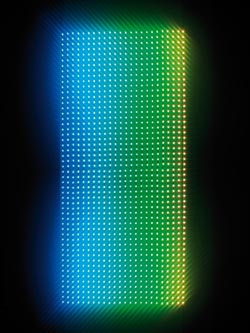
An extremely bright semi-transparent LED wall, the Martin LED curtain offers true RGB color illumination and features an automatic color calibration technique which assures that colors are always balanced to each other and show correctly. Useful in a wide variety of applications - and specially prepared for TV studios due to the (Genlock) feature; no cumbersome external power supplies are necessary as each unit features a direct power in and power out connector. Each unit contains a switch mode power supply covering all worldwide voltages, so there is only need for one unit type anywhere you travel. In addition, the LED curtain has direct in and out DVI connections for video signal with simple daisy chain capability. Light weight yet with a tough construction built to withstand the rigors of the touring market, modules are exceptionally service friendly. Easy to assemble, they come in a 2 x 1 meter size.
